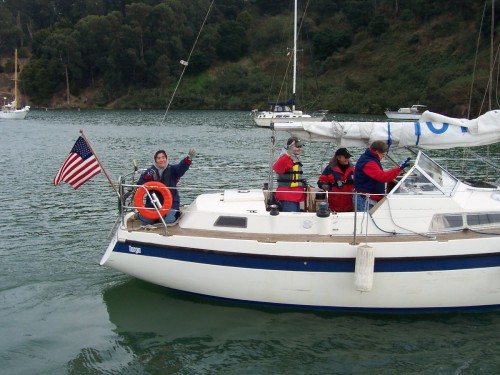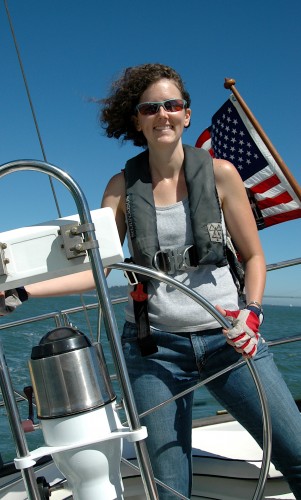So lets assume that you read our previous article “Volunteer Crewing 101” and though you may have some reservations, the idea of travelling around the world on someone else’s luxury yacht for months on end visiting far flung tropical islands with your only expense being the cost of groceries appeals to you.
(Look, if the opportunity to travel to Tahiti for free doesn’t get your attention then there is simply something wrong with you.
Let’s also assume you have never once in your life set foot upon a ship. How do you go from clueless landlubber to salty swabbie? Or at least how do you check this out for yourself and see if the sailor’s life is, indeed, for you?
Is any of the stuff we’re about to go over required to be a volunteer crew? No, no it is not. Can you just find a boat, step onboard having zero experience, and sail off into the sunset? Yes actually, yes you can. We have met several people out on the sea who did just that. Will these ideas make your first experience on a ship far better for both you and your first captain? Yes, it will.
There are several options, some free ones even, that can get that first shot of sea salt into your veins as gently as possible. Let’s take a look at a few –
Pay for a “Sailing Experience”
Many costal cities around the world offer tourists a chance to go out on a sailboat for a day. We don’t recommend this if you’re looking to get a feel for sailing. The reason is that these “sailing experiences” often cost just as much as a basic level sailing course but for the same price you aren’t getting any real instruction or knowledge. It’s more of a canned tourist experience vice an actual course to teach you nautical skills. You’re a paying passenger instead of a student and the difference between a tour guide and a sailing instructor will significantly change your experience. If you’re just looking for a good time, by all means, do the tour because they can be fun but just understand it won’t be reflective of the same experience you will have on a private sailing yacht.
 A much smarter and usually cheaper option is to ask at local sailing schools (see below) if they have a ‘try sailing for an evening’ program or something like that. For example, one of the sailing schools Tiffany taught for – Afterguard Sailing Academy – had a Wednesday evening sailing program where for $15 USD per person anyone could show up after work and an instructor would take them out in a group for 2 or 3 hours to get a taste of sailing. Another school – Tradewinds Sailing School and Club – Tiffany worked with had 2 or 3 days in the summer where for around $25 USD per person you could go out for a whole day!
A much smarter and usually cheaper option is to ask at local sailing schools (see below) if they have a ‘try sailing for an evening’ program or something like that. For example, one of the sailing schools Tiffany taught for – Afterguard Sailing Academy – had a Wednesday evening sailing program where for $15 USD per person anyone could show up after work and an instructor would take them out in a group for 2 or 3 hours to get a taste of sailing. Another school – Tradewinds Sailing School and Club – Tiffany worked with had 2 or 3 days in the summer where for around $25 USD per person you could go out for a whole day!
It’s a cheaper option for you and if you like it you can come back again or sign up for a course. This is probably your best bet for an easy and inexpensive way to test out sailing.
Check out a Yacht club
We know right? Don’t worry, no ascots required. Actually, funny thing is that for many yacht clubs, you don’t even need a yacht to join! The situation varies from club to club but in general, yacht clubs are primarily a social group of people who happen to be into boats. Some people own them, some people don’t, but the yacht club brings them all together.
 Someone here needs a spare pair of hands.
Someone here needs a spare pair of hands.
A simple Google search will bring up any yacht clubs in your area and if that fails, call your nearest boat store or marine equipment store – they should be able to at least point you in the right direction. Call the club instead of just showing up, as many are only open at certain times. Simply ask someone about taking a tour and details about joining. Explain to them what you are looking for and what your experience is, even if its zero. Most yacht club people are pretty nice and want to promote sailing so they will be glad to help you out.
Entry requirements, joining fees, dues and everything else varies wildly depending on where you are and who the club caters to so shop around if you’re looking to actually join up.
Join a racing team
“Whoa there, what? I don’t even know what I’m doing yet!”
Well that’s ok, we’re not talking about the Olympics here. People who own boats often get together and do what’s called “beer can races.” Which are named after the buoys they race around (commonly called cans) … and what most of the crew does afterwards (with the beer). Some races are very serious indeed while others are more social events than competitions. In either case, boat owners need race crew to help them show up their friends and that’s where you come in. If you can commit some regular time (usually one evening a week) have a good attitude and are willing to learn, then you might be exactly what these people are looking for. It is helpful if you at least know the basics but many teams are willing to lend you their knowledge in exchange for your effort. Or just show up an hour or two early with a six pack of beer and start asking around. Sailors see someone walking around with beer and usually they become really helpful very quickly.
 The reason it’s a stereotype is because it’s true!
The reason it’s a stereotype is because it’s true!
The hidden upside to this method is that in addition to making new friends, learning a new skill and upgrading your social life, you also can brag about your “yacht racing team” which should turn some heads.
To find social races you can ask at local yacht clubs (they usually sponsor the races and are the first stop for people looking for crew) search online, ask around at local marinas, marine shops and harbor masters, check local sailing magazines or check local online crew lists.
Take a class
This is a more costly option. It’s best saved for after you’ve tested the waters and are sure you want to jump in to this whole sailing thing with a little more gusto. In many coastal cities there are sailing schools offering a variety of courses that can teach you everything from basic seamanship to advanced navigation and even how to sail by the stars. The two main organizations that oversee these schools in the US are the American Sailing Association (ASA) and US Sailing. Just swing over to either website and you’ll be able to find information on courses, costs and schools throughout the country that offer the classes along with how to contact them. What you’re looking for in ASA terms is the “Basic Keelboat” course. This course costs about $400 and will give you all the basic skills you need to know in about two days. Also, as part of the course you get to actually get out there and go sailing on a boat with an instructor for a day so you can really see if this whole thing is for you. In addition to giving you basic knowledge you will need to operate a ship, taking a course from a recognized school will give you credentials that will allow you to charter and rent ships around the world. Yes, that is as cool as it sounds.
 Be sure to get the helmsman picture. It’s very important.
Be sure to get the helmsman picture. It’s very important.
So as you can see, there are options for everyone’s budget even if that budget is nothing more than elbow grease. The important thing is to get out there and give this a go. What started for us as sailing in the Oakland estuary for $15 one evening ended up getting Tiffany a job she can take anywhere in the world and both of us free tickets from San Diego to Australia by way of Tahiti on a private yacht! It sounds unbelievable we know but that’s exactly what happened to us! So get out there, test out those sea legs and see where you end up!
Greg and Tiffany are traveling around the world on sailing yachts and keep a video blog of their (mis)adventures. If sailing to Tahiti on a 44 ft sailboat, 3-day delays for wine tastings, getting pooped on by seagulls, opening coconuts with dull machetes, sailing past tornadoes and ukulele Christmas carols are for you, then check them out at www.CoastGuardCouple.com!





This is really great advice! I have thought about this before, but it almost seems impossible to get started! Thanks for this post
Thanks Jade,
Since stumbling upon volunteer crewing and seeing how far it can take you we have noticed that there isn’t a lot of information about this out there. We’re doing our best to fix that!